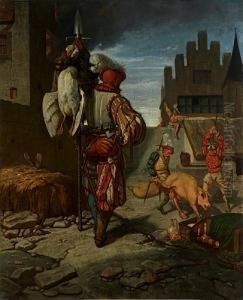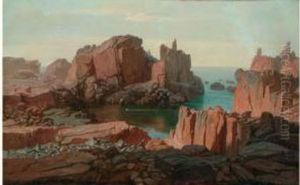Octave Penguilly-L Haridon Paintings
Octave Penguilly-L'Haridon was a French painter and illustrator born on April 31, 1811, in Paris, France. He was known for his historical scenes and his interest in Breton themes, which were inspired by his Breton heritage and frequent visits to Brittany. Penguilly-L'Haridon began his artistic education under the guidance of his father, who was an artist and a teacher. He later continued his studies at the prestigious École des Beaux-Arts in Paris, where he trained under renowned painter Guillaume Guillon Lethière.
His early career was marked by his participation in the Salon, the official art exhibition of the Académie des Beaux-Arts in Paris. Penguilly-L'Haridon made his debut at the Salon in 1833 and regularly exhibited his works there, gaining public recognition and critical acclaim. One of his most famous paintings, 'The Combat of the Thirty' (1857), depicts a legendary medieval combat between Breton and English knights and is considered one of his masterpieces. This work reflects his meticulous approach to historical accuracy and his interest in the chivalric past.
Throughout his career, Penguilly-L'Haridon was a proponent of historical painting, believing that art should serve to educate and elevate the public by presenting moral and historical lessons. His works often feature dramatic compositions and a keen attention to detail, both in the depiction of historical costumes and settings. Besides historical subjects, he also painted landscapes, which were influenced by his travels around Brittany and his admiration for the rugged Breton coastline and its inhabitants.
Penguilly-L'Haridon was also involved in the early days of photography and was interested in its potential for artistic expression. His engagement with photography likely influenced his approach to composition and lighting in his paintings. Despite his success, Octave Penguilly-L'Haridon never achieved the same level of fame as some of his contemporaries. However, he left behind a body of work that is appreciated for its historical value and artistic quality.
He passed away on April 12, 1870, in Paris. Today, his works can be found in various museums across France, including the Musée des Beaux-Arts in Rennes and the Musée d'Orsay in Paris. His legacy continues to be appreciated by art historians and enthusiasts, particularly for his contributions to the genre of historical painting and his dedication to capturing the spirit of Brittany.



